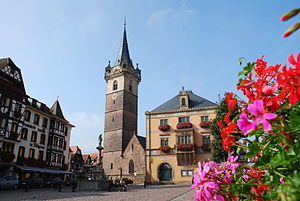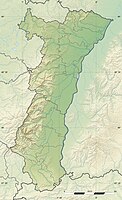 Marktplatz and Kappelturm | ||
| Oberehnheim | ||
| department | Bas-Rhin | |
|---|---|---|
| Residents | 11.350 (2018) | |
| height | 185 | |
| other value for height on Wikidata: 156 m | ||
| Tourist info web | http://www.obernai.fr/ | |
| no tourist info on Wikidata: | ||
| location | ||
| ||
Obernai (dt. Oberehnheim) is one french City in the department Bas-Rhin in the Alsace on the Alsatian Wine Route (Route des vins d'Alsace).
background
Politically, the city belongs to the arrondissement Sélestat-Erstein and is the administrative seat of the canton Obernai.
The medieval town is located at the foot of Mount Odile (Mont Sainte-Odile). Here is the holy Odilia have been born. In the 7th century, the Frankish settlement was probably located here, which was the seat of the Merovingian Athich (also Eticho, Etih or Adalricus), Count of Alsace, whose daughter Odilia was. The village is mentioned for the first time under the name Ehinheim, only in the year 778. In the 12th century the city came into the possession of the Holy Roman Empire. The city's double fortified city walls also date from this period. In 1242 the modern name Oberehnheim ("Oberhehenheim") was mentioned for the first time to differentiate it from Niederehnheim and has been used since then. Between 1240 and 1648 Oberehnheim was a free imperial city and in 1354 joined the Alsatian League of Ten Cities. The city was able to repel Charles the Bold's siege attempts in 1444. The city's heyday was in the 16th century, during the time of the Reformation, which was pushed back in 1587. Oberehnheim was almost completely destroyed during the Thirty Years War. The then rebuilt city was never affected by a major fire that was otherwise typical of that time, so that many buildings from this time have been preserved. In 1679 the city was annexed by Louis XIV. The French form of the name Obernai ("Oberné") was first used in 1693. This name quickly caught on with the local population, so that both names were in use between 1871 and 1918, when the city was again German.
getting there
By plane
By train
By bus
In the street
- Route des vins d'Alsace. Alsatian wine route.
mobility

Tourist Attractions
- city wall. The city wall with its semicircular towers can partially be walked on. Of the former 52 towers, 30 are still preserved.
- Église Saint-Pierre-et-Saint-Paul. The town church was built as a neo-Gothic building between 1867 and 1873. This is located on the forecourt Monument to the cleric Charls Freppelwho was born in the city. The church still has 4 glass windows from the previous building. These were made around 1480 by Peter Hemmel from Andlau. In the left transept is the reliquary with the heart of Charles Freppel.
- synagogue. The neo-Romanesque synagogue from 1876 is located on the eastern city wall.
- Place du Marche. The market square with the six-bucket fountain.
- Puitts aux Six Seaux. The six-bucket fountain is probably the most famous Renaissance fountain in Alsace. It was built in 1579. It is spanned by a canopy supported on three ornate Corinthian columns. An angel blowing a trumpet stands on the canopy and scriptures are carved into it.
- Hotel de Ville. The town hall, built in 1462, rebuilt in 1523 and provided with a balcony in 1604.
- Tour de la chapelle, Beffroi. The chapel tower is the remnant of the Gothic church that was demolished in 1873 and dates from the 13th and 16th centuries. Century.
- Ancienne Halle aux Blés. Former granary from 1554, today converted into a restaurant.
activities
shop
kitchen
nightlife
accommodation
security
health
Practical advice
- Tourist office, Place du Beffroi - BP 104, 67213 Obernai Cedex. Tel.: 33 388 95 64 13, Fax: 33 388 49 90 84, Email: [email protected].
trips
literature
Web links
- http://www.obernai.fr - Obernai official website
- Tourism website Obernai

